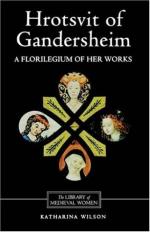|
This section contains 4,343 words (approx. 15 pages at 300 words per page) |

|
SOURCE: "Hroswitha and the Feminization of Drama" in Women in Theatre, edited by James Redmond, Cambridge University Press, 1989, pp. 49-58.
In the following essay, Schroeder observes proto-feminist themes in Hroswitha's plays, especially "the thematic pattern of feminine weakness overcoming masculine strength."
Most non-specialists who think about Hroswitha at all tend to think of her largely as a freak of literary history, a kind of duck-billed platypus standing outside the normal flow of evolution—in this case, the evolution of Christian drama in the Middle Ages. Yet our perception of her as a sideshow exhibit—the tenth-century nun who wrote religious plays in imitation of Terence—can prove an obstacle when we come to examine her actual accomplishment: the mere existence of Hroswitha's plays seems odd enough to keep us from finding out if they are anything more than oddities. This paper, ignoring literary history, will take Hroswitha for...
|
This section contains 4,343 words (approx. 15 pages at 300 words per page) |

|


